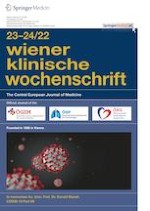24.05.2022 | original article
Comorbidities and COVID-19 hospitalization, ICU admission and hospital mortality in Austria
A retrospective cohort study
Erschienen in: Wiener klinische Wochenschrift | Ausgabe 23-24/2022
Einloggen, um Zugang zu erhaltenSummary
Background
The protection of vulnerable populations is a central task in managing the Coronavirus disease 2019 (COVID-19) pandemic to avoid severe courses of COVID-19 and the risk of healthcare system capacity being exceeded. To identify factors of vulnerability in Austria, we assessed the impact of comorbidities on COVID-19 hospitalization, intensive care unit (ICU) admission, and hospital mortality.
Methods
A retrospective cohort study was performed including all patients with COVID-19 in the period February 2020 to December 2021 who had a previous inpatient stay in the period 2015–2019 in Austria. All patients with COVID-19 were matched to population controls on age, sex, and healthcare region. Multiple logistic regression was used to estimate adjusted odds ratios (OR) of included factors with 95% confidence intervals (CI).
Results
Hemiplegia or paraplegia constitutes the highest risk factor for hospitalization (OR 1.61, 95% CI 1.44–1.79), followed by COPD (OR 1.48, 95% CI 1.43–1.53) and diabetes without complications (OR 1.41, 95% CI 1.37–1.46). The highest risk factors for ICU admission are renal diseases (OR 1.76, 95% CI 1.61–1.92), diabetes without complications (OR 1.57, 95% CI 1.46–1.69) and COPD (OR 1.53, 95% CI 1.41–1.66). Hemiplegia or paraplegia, renal disease and COPD constitute the highest risk factors for hospital mortality, with ORs of 1.5. Diabetes without complications constitutes a significantly higher risk factor for women with respect to all three endpoints.
Conclusion
We contribute to the literature by identifying sex-specific risk factors. In general, our results are consistent with the literature, particularly regarding diabetes as a risk factor for severe courses of COVID-19. Due to the observational nature of our data, caution is warranted regarding causal interpretation. Our results contribute to the protection of vulnerable populations and may be used for targeting further pharmaceutical interventions.
Anzeige
